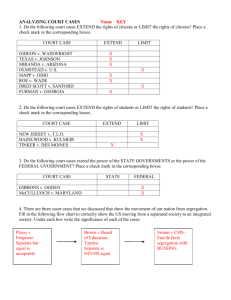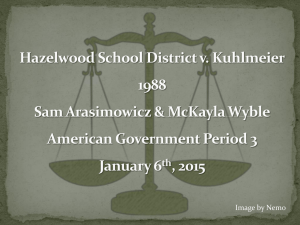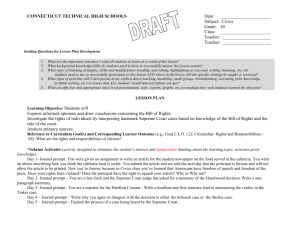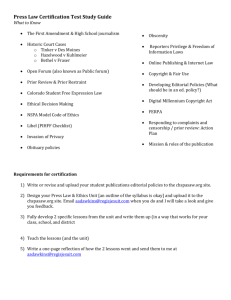Plessy v. Ferguson
advertisement
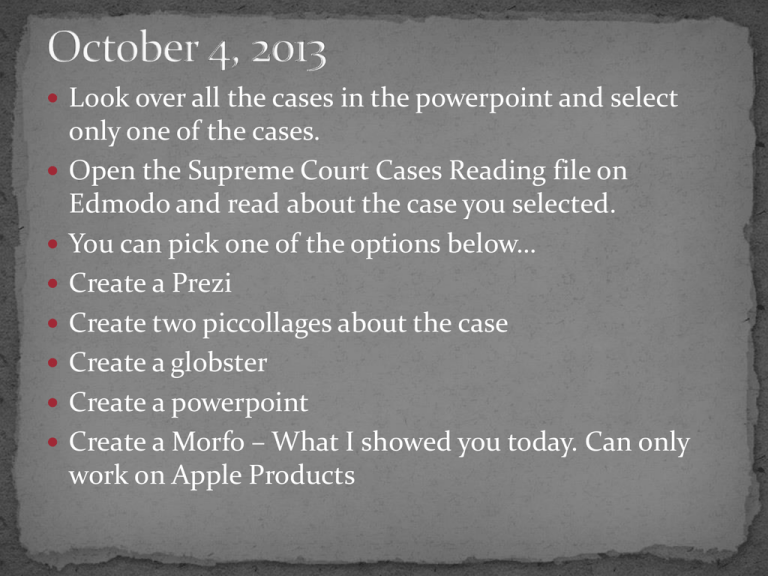
Look over all the cases in the powerpoint and select only one of the cases. Open the Supreme Court Cases Reading file on Edmodo and read about the case you selected. You can pick one of the options below… Create a Prezi Create two piccollages about the case Create a globster Create a powerpoint Create a Morfo – What I showed you today. Can only work on Apple Products You have the give some type of summary of the case You must include why you think that this case is important. You must have illustrations about the case. ONCE YOU ARE DONE, SUBMIT YOU MINI PROJECT TO EDMODO.!!! Supreme Court Landmark Cases Marbury v. Madison 1803 Background Information •President John Adams appointed John Marshall as the new Chief Justice of the Supreme Court and William Marbury as the Justice of Peace for the District of Columbia before Thomas Jefferson took Office. Marbury v. Madison •Not all of the appointments were finalized before the end of Adams presidency. •President Thomas Jefferson believed the remaining commissions because they were no longer valid. •Marbury (one of Adams’ appointees) sued Madison for his government position. Marbury v. Madison Results •Six (6) votes for Madison. •Helped define the checks and balances system. •Established the Supreme Court’s power of judicial review. Plessy v. Ferguson 1896 Background Information •During this time, whites and blacks were required to ride in separate railway cars under Louisiana Law. •Although Homer Plessy was seven-eighths (7/8) white, he was required to ride the “colored” car. Plessy v. Ferguson •Plessy was arrested for refusing to leave the “whites-only” railway car. •He took his case to state court because he felt segregation violated his Constitutional rights (14th Amendment). •The Louisiana judge, John Ferguson, ruled that Louisiana can enact segregation laws within the state. •The case was taken to the United States Supreme Court. Plessy v. Ferguson Results •Seven (7) votes for Ferguson. •This decision upheld the separate-but-equal doctrine, that separate facilities for blacks and whites satisfied the Fourteenth (14th) Amendment as long as they are “equal”. Brown v. Board of1954Education Background Information •Black children were NOT allowed to attend the same public schools as white children because laws permitted racial segregation. Brown v. Board of Education •Several parents of black children, including Oliver Brown, sued the Topeka School Board claiming racial segregation is unequal and violates the Fourteenth (14th) Amendment. •Lower courts agreed with the school system; the case was brought to the United States Supreme Court. Brown v. Board of Education Results •Nine (9) votes for Brown. •The Supreme Court overruled Plessy v. Ferguson •Racial segregation in public education is unconstitutional. Gideon v. Wainwright 1962 Background Information •Clarence Gideon was arrested and charged in Florida court for breaking and entering. •He was unable to afford a lawyer and the court refused to appoint a free lawyer. Gideon v. Wainwright •Gideon was forced to defend himself in court and the jury found him guilty. •He appealed the court’s decision to the United States Supreme Court claiming it violated his rights under the Sixth (6th) and Fourteenth (14th)Amendment. Gideon v. Wainwright Results •Nine (9) votes for Gideon. •The Supreme Court held that Gideon and other poor defendants in criminal cases have the right to a courtappointed attorney. Miranda1966v. Arizona Background Information •Arizona arrested Ernesto Miranda for kidnapping and the state court found him guilty. •He was questioned without being advised of his right to consult with an attorney or any of his other legal rights. Miranda v. Arizona •Miranda appealed his conviction to the Supreme Court claiming the police violated his rights under the Fifth (5th) Amendment (self-incrimination). Miranda v. Arizona Results •Five (5) votes for Miranda, Four (4) votes for Arizona. •The decision held that the police cannot question a person in custody unless they have been read their legal rights. 1. The right to remain silent 2. The right to an attorney (at government expense if the accused is unable to pay) 3. Anything the person says after stating that he or she understands these rights can be used as evidence in court. Tinker v. Des Moines School1968 District Background Information •John Tinker, his sister Mary Beth Tinker, and other students decided to wear black armbands to school in protest of the Vietnam War. •The school adopted a policy prohibiting armbands. Tinker v. Des Moines School District •When the students arrived to school, they refused to remove their armbands and were suspended. •They claimed the school officials violated their First (1st) Amendment rights. Tinker v. Des Moines School District Results •Seven (7) votes for Tinker, Two (2) votes against. •The students were allowed to wear armbands because it is protected by the First (1st) Amendment. Hazelwood School District v.1987 Kuhlmeier Background Information •Students of Hazelwood East High School wrote and edited the school-sponsored newspaper. •The school principal removed two articles from the issue and claimed they were inappropriate. Hazelwood School District v. Kuhlmeier •Cathy Kuhlmeier and two other students brought the case to court because they believed the principal violated their First (1st) Amendment rights. Hazelwood School District v. Kuhlmeier Results •Five (5) Votes for the Hazelwood School District, Three votes for Kuhlmeier •The Supreme Court ruled that school officials have the right to censor articles in the student newspaper or limit speech that interferes with the school’s educational mission.
